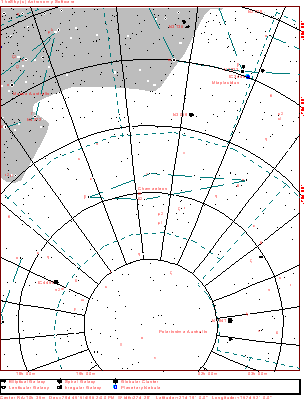
| Home | Deepsky Atlas | TheAstronews | Links | Solar System | ||||||

Hawaiian Astronomical SocietyConstellations: Chamaeleon -- Well Hidden |
||||||||||
Chameleons can change color, and have toes fused into groups of two and three, teeth attached to the edge of the jaw, and a long tongue. Like its namesake in the animal kingdom, this constellation does not stand out.

Click the map for a 916x1200 version of the above. Click here for a map better suited for use in the field.

This a more detailed view of the constellation. The map displays stars to magnitude 10, and deepsky objects to magnitude 12. Click here for a map better suited for use in the field.
 20k JPEG One of Dreyer's remarkable objects, Caldwell 109 (NGC3195) is a planetary nebula described as fairly bright (no magnitude given, the central star is mag. 15.3), small (.7'x.5'), with little elongation. Most telescopes show 2 fairly prominent stars to the west (right). 20k JPEG One of Dreyer's remarkable objects, Caldwell 109 (NGC3195) is a planetary nebula described as fairly bright (no magnitude given, the central star is mag. 15.3), small (.7'x.5'), with little elongation. Most telescopes show 2 fairly prominent stars to the west (right).
|
If you have any questions about the Hawaiian Astronomical Society
please
(link requires javascript).